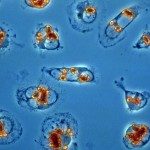Link to Pubmed [PMID] – 30911045
Link to DOI – 10.1038/s41598-019-41640-0
Sci Rep 2019 03; 9(1): 5074
Leishmania parasites are thought to control protein activity at the post-translational level, e.g. by protein phosphorylation. In the pathogenic amastigote, the mammalian stage of Leishmania parasites, heat shock proteins show increased phosphorylation, indicating a role in stage-specific signal transduction. Here we investigate the impact of phosphosites in the L. donovani heat shock protein 90. Using a chemical knock-down/genetic complementation approach, we mutated 11 confirmed or presumed phosphorylation sites and assessed the impact on overall fitness, morphology and in vitro infectivity. Most phosphosite mutations affected the growth and morphology of promastigotes in vitro, but with one exception, none of the phosphorylation site mutants had a selective impact on the in vitro infection of macrophages. Surprisingly, aspartate replacements mimicking the negative charge of phosphorylated serines or threonines had mostly negative impacts on viability and infectivity. HSP90 is a substrate for casein kinase 1.2-catalysed phosphorylation in vitro. While several putative phosphosite mutations abrogated casein kinase 1.2 activity on HSP90, only Ser289 could be identified as casein kinase target by mass spectrometry. In summary, our data show HSP90 as a downstream client of phosphorylation-mediated signalling in an organism that depends on post-transcriptional gene regulation.



